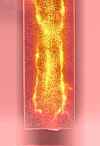



Microwave discharges at the surfaces of dielectrics
Electrodeless pulsed microwave discharges occurring at the surface of insulating crystals in the vacuum are being studied both experimentally and theoretically. Investigations of nonlinear physical phenomena developing in the near-surface layer of insulating crystals (excited by pulsed microwave discharges) are in progress. A classification of different types of electrodeless pulsed microwave discharges is under development. Of special interest are those physical processes in the near-surface layer of insulating crystals which bring about the accumulation of high concentrations of radiation-induced point defects, the arising of luminescence of induced color centers, the appearance of induced electrical conductivity, the stimulation of strong absorbtion of microwave power, the occurring of both a contracted discharge and an electrodeless breakdown of crystals in a field of microwaves. Characteristics of planar optical waveguides created at the surface of insulating crystals (previously colored by microwave discharges) will be under investigation both experimentally and theoretically. On the basis of the created waveguides a number of new devices important for integrated optics and fiber optics will be developed. The most important devices are miniature lasers and optical amplifiers which will be frequency-tuned in the near infrared spectral range.
The obtained results conform to world scientific standards and have a priority nature. These results are published in prestige scientific journals (Sov. Phys.- J. Tech. Phys. Letters, Sov. Phys. - J. Exp. Teor. Phys. (JETP) Letters, Physica Status Solidi) as well as in proceedings of large international conferences (ICPIG XXI; ICPIG XXII; Strong Microwaves in Plasmas 1990, 1996).
Main scientific topics within the framework of formulated problems. Basic studies:
Applied
studies: Study
of microwave discharges at the surface of insulating crystals and
other materials from the point of view of raising an electric strength
of output windows of microwave devices and waveguides during powerful
microwave radiation propagates through the windows;
Creation
and study of planar optical waveguides on the surface of insulating
crystals (previously colored by microwave discharges);
Creation
of miniature integrated-optics and fiber-optics lasers and optical
amplifiers (frequency-tuned in the near infrared spectral range) at
the surface of insulating crystals containing color centers induced
by pulsed microwave discharges;
It
is possible also to perform the investigations on the interaction
of microwaves with solids for solving the urgent problems of processing
and modification of insulators and semiconductors:
-
creation of sensitive optical storage media at the surface of insulating
crystals previously colored by microwave discharges,
Investigations
of the following phenomena taking place in plasma-flare microwave
discharges (developing at the surface of insulators) were performed:
- excitation of langmuir waves in a plasma resonance region, - acceleration of electrons due to a self-breaking of strong langmuir waves, - acceleration of ions due to a potential jump in a plasma resonance region, - transformation of microwave power to the power of quasistationary electric current in the plasma. A
new type of breakdown was observed at the surface of solids - microwave
breakdown of insulating crystals initiated by a secondary-electron-emission
microwave discharge. The conditions of excitation of the secondary-electron-emission
discharge and the mechanisms for transformation of the one to the
plasma-flare microwave discharge were determined
It
was established that microwave breakdown of insulating crystals is characterized
by threshold values of both power and duration of single pulses of microwave
radiation.
It
was found that microwave breakdown of insulating crystals is accompanied
by a pronounced absorbtion of microwave energy, an intense flash of
light, and a formation of contracted discharge and breakdown channel
at the surface of crystals.
The
velocity of formation of the contracted discharge was determined. Evaluations
of values of both an electrical conductivity and an electron density
in the breakdown channel at the surface of crystals were performed.
It
is shown that the further evolution of the contracted discharge is accompanied
by evaporation, dissociation, ionization, and explosive fly to bits
of the material in the breakdown channel. In such a way the plasma-flare
microwave discharge is formed.
It
was found that the characteristic duration of luminescence growth/decay
(for LiF, NaCl, KCl, CsJ crystals excited by pulsed microwave discharges
at room temperature) is about 1-2 microseconds.
Optical-absorption
spectra of LiF crystals previously colored by microwave discharges were
measured. The induced F, F2, F3-, F3,
F3+, N centers stable at room temperature were observed.
It
is shown that a density of induced aggregate F2 and F3+
color centers is about a density of induced F centers. This fact testifies
a high-intensive excitation of LiF crystals by microwave discharges.
Luminescence
spectra of LiF crystals (previously colored by microwave discharges)
excited by laser were obtained. Optical characteristics of F2
and F3+ centers in LiF crystals were measured. Similarity
of investigated here color centers with those produced in gamma-irradiated
LiF crystals was obtained.
It
was measured (at room temperature) a luminescence spectrum of short-lived
F2 and F3+ color centers temporaly induced in
uncolored LiF crystals by pulsed microwave discharges at the pre-breakdown
stage of evolution. The spectrum is very close to the one that was measured
for LiF crystals (previously colored by microwave discharges and containing
F2 è F3+ centers) excited by laser.
The
explanations of origin and further evolution of pulsed microwave discharges
were done on the basis of the idea of high-intensive excitation of electronic
subsystem of solids. A relaxation of the excitation in the near-surface
layer of insulating crystals leads to a creation of short-lived color
centers with high density. A recombination of induced color centers
brings about the microwave breakdown of the crystals.
The
following original techniques for investigation of processes developing
in the crystals and in the plasma-flare microwave discharges have been
proposed and applied in experiments:
- the photoelasticity technique for studying of strong acoustic waves in the bulk of crystals excited by pulsed microwave discharges; - the techniques for resonance-laser-absorbtion and resonance-laser-fluorescence measurements of probe laser beams for studying of movement of Na (or Cs) atoms emitted from the surface of NaCl (or CsJ) crystals as a result of microwave breakdown. These techniques as applied to study of pulsed microwave discharges developing at the surface of insulating crystals are unique. Methods
for selective formation of induced color centers (stable at room temperature)
in the near-surface layer of insulating crystals, excited by microwave
discharges, were developed.
Methods
for creation of an optically-dense layer on the surface of insulating
crystals during coloring by microwave discharges were developed.
Processes
of excitation and maintenance of electrodeless microwave discharges
on a surface of dielectric crystals were studied. In the process, radiation
defects (color centers) are created in the near surface layers of the
crystals. Kinetics of accumulation and relaxation of metastable and
stable defects in the crystals, excited by microwave discharges, was
studied. It was shown, that a high density of defects in the crystals
considerably changes the characteristics of microwave discharges, developing
on the surface of dielectric crystals. For example, when compared to
uncolored crystals, the excitation of microwave discharges on the surface
of colored lithium fluoride (LiF) crystals (containing induced stable
F2 è F3+ color centers with high density
~1x(1020-1021) ñì-3)
is accompanied by considerable decrease of electron current from the
discharge and luminescence intensity of induced F2 è
F3+ color centers. It was found that under this conditions
the luminescence kinetics of LiF crystals (excited by microwave discharges)
changes substantially: in the bands of light emission of induced F2
è F3+ color centers (in the wavelength regions 670±30
nm and 540±30 NM) there appear, together with slow components
of luminescence ~ 1 microsecond (typical for uncolored crystals), fast
components (typical for colored crystals) with characteristic intensity
rise and fall times ~ 0.1 microsecond.
The
physical mechanisms and dynamics of formation of induced electrical
conductivity in the near-surface layer of dielectric crystals, excited
by electrodeless microwave discharges, were studied. It was shown that
microsecond microwave discharge at the pre-breakdown stage of development
gives rise to a high-intensive excitation of the surface layer of the
crystals. It was found that excitation of the surface layer of LiF crystals
by low-energy electrons from a microwave discharge with a characteristic
electron energy of 1 keV, electron density 1x1010 cm-3,
and microwave discharge pulse duration 1 microsecond is characterized
by a specific input energy density ~ 500 J/cm3. In the process,
the excitation is accompanied by creation of short-lived aggregate F2
è F3+ color centers with high density ~1x(1020-1021)
ñì-3 in the surface layer of LiF crystals.
These values are several orders of magnitude higher than the corresponding
ones when LiF crystals are excited with high-current pulsed electron
beams, x rays or gamma rays. It is proposed the physical model of transformation
of secondary-electron-emission microwave discharge to plasma-flare microwave
discharge as a result of formation of contracted discharge and arising
electrodeless microwave breakdown of dielectric crystals.
[1] G.M.Batanov, V.A.Ivanov, I.A.Kossyi, K.F.Sergeichev. Large-Amplitude Plasma Waves and Particle Acceleration in the Plasma Corona of a Microwave Discharge. Sov. Phys. - J. Plasma Physics, 1986. Vol. 12. No. 5. Pp. 317-325. [2] G.M.Batanov, V.A.Ivanov. Plasma-Flare Conversion of the Energy of Microwaves in the Decimeter Band into the Energy of Quasi-Stationary Electric Current . /In: "Generation of Nonlinear Waves and Quasistationary Currents in Plasma", Ed. by L.M.Kovrizhnykh. New-York: Nova Science Publishers, Inc., 1992. 227 p.(Proc. of the Institute of General Physics, Academy of Sciences of the USSR. Moscow: Nauka, 1988. Vol. 16. Pp. 46-79 [in Russian]). [3] G.M.Batanov, V.A.Ivanov, M.E.Konyzhev et al. Generation of High Potentials in the Plasma by the Interaction with Intense Microwave Radiation. /Proc. Of the International Workshop on Strong Microwaves in Plasmas. Suzdal (USSR), September 17-22, 1990. [4]
V.A.Ivanov, M.E.Konyzhev et al. Generation of High Potentials and
Fast Electron Diagnostic in Microwave Produced Plasma Flare. /Proc.
Of the XX-th International Conference on Phenomena in Ionized Gases.
Contributed [5]
G.M.Batanov, V.A.Ivanov, M.E.Konyzhev, V.A.Konyushkin, and S.B.Mirov.
Coloration of LiF Single-Crystals by Surface Microwave Discharges.
/Proc. Of the International School of Plasma Physics (ISPP-13 "Piero
Caldirola"). [6] G.M.Batanov, V.A.Ivanov, M.E.Konyzhev, V.A.Konyushkin, and S.B.Mirov. Microwave Discharge Method for Formation of Optically-Dense Submicron- Thickness Layers with High Concentrations of Color Centers on the Surfaces of Alkali-Halide Crystals /Proceedings I. XXI International Conference on Phenomena in Ionised Gases. Pp. 37-38. Sept. 19-24, 1993. Rurh-University, Bochum, Germany. [7] G.M.Batanov, V.A.Ivanov, M.E.Konyzhev, V.A.Konyushkin, and S.B.Mirov. Creation of an Optically Dense Layer on the Surface of a Lithium Fluoride Crystal During Coloring in a Microwave Discharge. Sov. Phys. - J. Tech. Phys. Lett., 1993. Vol. 19. No. 11. Pp. 653-654. [8]
G.M.Batanov, V.A.Ivanov, M.E.Konyzhev. Microwave Breakdown of Ionic
Crystals Initiated by a Secondary-Emission Discharge. Sov. Phys.
- J. Exper. Theor. Phys. Lett. (JETP Lett.), 1994. Vol. 59. No. 10.
Pp. [9] G.M.Batanov, V.A.Ivanov, M.E.Konyzhev. Microwave Breakdown on the Surface of Ionic Crystals in Vacuum. XXII Conference on Phenomena in Ionized Gases. Vol.IV. /Editors: K.H.Becker, W.E.Carr, E.E.Kunhardt. Hoboken, New Jersey, USA, 1995. Pp. 143-144. [10] G.M.Batanov, V.A.Ivanov, M.E.Konyzhev. Luminescence of short-lived color centers in LiF crystals excited by secondary-electron emission microwave discharge. /In book: Strong Microwaves in Plasmas. Vol.1. Ed. By A.G.Litvak. Nizhny Novgorod: Institute of Applied Physics, 1997. Pp. 401-406. [11] V.V.Ter-Mikirtychev, T.Tsuboi, M.E.Konyzhev, V.P.Danilov. Spectroscopic characteristics of color centers produced in a LiF crystal surface layer by microwave discharge. Phys. Stat. Solidi (b), 1996. Vol. 196. No. 1. Pp. 269-274. [12] G.M.Batanov, V.A.Ivanov, M.E.Konyzhev, A.A.Letunov. Luminescence of short-lived color centers induced in LiF crystals by a pulsed microwave discharge. Sov. Phys. - J. Exper. Theor. Phys. Lett. (JETP Lett.), 1997. Vol. 66. No 3. Pp. 170-174.
Available installation and scientific equipment. 1. The experimental installation consists of the following main components: pulsed
magnetron (microwave power is up to 5 ÌW, oscillation frequency
of microwaves is 2 GHz, pulse duration ranges from 1 to 50 ms),
waveguide
for delivery of microwave power from the magnetron to the vacuum chamber,
titanium
pumps for pumping down the chamber to a high vacuum,
high-voltage
rectifier unit,
pulsed
modulator unit,
power
sources.
2. Scientific equipment consists of the following main components: directional
waveguide couplers for measurements of power of the incident to the
discharge and reflected from the discharge pulsed microwave radiation,
optical
techniques for measurements of spectral and kinetic characteristics
of luminescence and optical-absorbtion of insulating crystals excited
by pulsed microwave discharges,
optical
techniques for measurements of both luminescence and optical-absorbtion
spectra of insulating crystals previously colored by pulsed microwave
discharges,
multigrid
electrostatic analyzers of energy of charge particles for measurements
of currents of electrons and ions from the region of microwave discharges,
photoelasticity technique for studying of strong acoustic waves in
the bulk of transparent insulating crystals excited by pulsed microwave
discharges;
optical
techniques for resonance-laser-absorbtion and resonance-laser-fluorescence
measurements of probe laser beams for studying of movement of NA (or
Cs) atoms emitted from the surface of NaCl (or CsJ) crystals as a
result of microwave breakdown.
integrated-optics
technique for study of characteristics of planar optical waveguides
created at the surface of insulating crystals previously colored by
microwave discharges.
If required, not only LiF crystals but also another insulating crystals will be used for studies.
|

